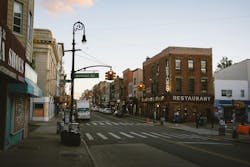NYC Considers $5.5M Pilot to Test Cooler Asphalt Technology in Heat-Vulnerable Neighborhoods
Key Takeaways
- The NYC Council Transportation Committee is evaluating a $5.5 million cool pavement pilot aimed at combating urban heat island effects in the city’s hottest neighborhoods.
-
Cool asphalt reflects sunlight and reduces heat absorption, potentially lowering surface temperatures by several degrees and improving street safety and livability.
-
The pilot program would launch in September 2026 in one high-heat, low-income neighborhood per borough, with results reported within 180 days of completion.
The New York City Council’s Transportation Committee is reviewing a proposal for a pilot program testing cooler asphalt, designed to lower pavement surface temperatures in neighborhoods most affected by urban heat.
According to the U.S. Environmental Protection Agency, cool pavement uses lighter-colored materials, coatings or grass to reflect sunlight rather than absorb it. Traditional pavement, by contrast, absorbs heat and radiates it back to the environment, exacerbating citywide temperature increases.
Brooklyn Councilwoman Sandy Nurse, who sponsored the legislation, said the measure addresses one reason why New York City often feels up to eight degrees hotter than the posted temperature.
Benefits of Cool Pavement Technology for Cities
In an interview with PIX11, Nurse said that cool pavement reduces surface heat while delivering additional infrastructure and environmental benefits — including:
- Lower stormwater runoff and improved water quality.
- Enhanced road safety and nighttime visibility.
- Reduced heat-related illnesses and infrastructure strain.
She also noted that cooler conditions can help boost local commercial activity, as pedestrian comfort increases and businesses benefit from more consistent foot traffic.
Although cool asphalt costs about $0.60 more per square yard than traditional materials, the American Society of Civil Engineers (ASCE) reports that long-term community benefits outweigh the short-term expense, the New York Post noted.
Pilot Program Details and Collaboration
If approved, the $5.5 million pilot program would take off on city streets in September 2026, targeting one neighborhood per borough with high heat exposure and a low median income.
According to PIX11, some potential candidates for the pilot program are Brownsville, East New York and Bushwick in Brooklyn and Cypress Hills in Queens — which have seen increased rate of heat-related illnesses.
The program would be a joint effort between the city Department of Transportation, Department of Health, Department of Environmental Protection and the Office of Long-Term Planning and Sustainability.
Following completion, NYC DOT would have 180 days to submit a report on the project’s results to the mayor and the City Council, according to the New York Post.
Sources: PIX11, New York Post
